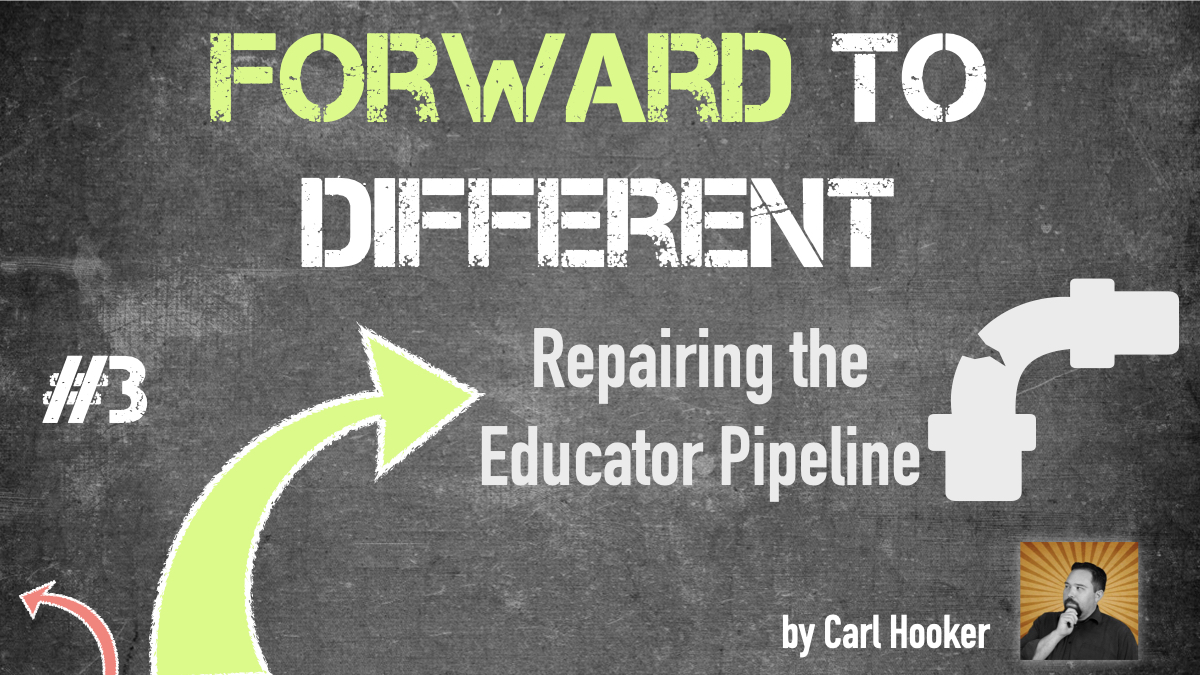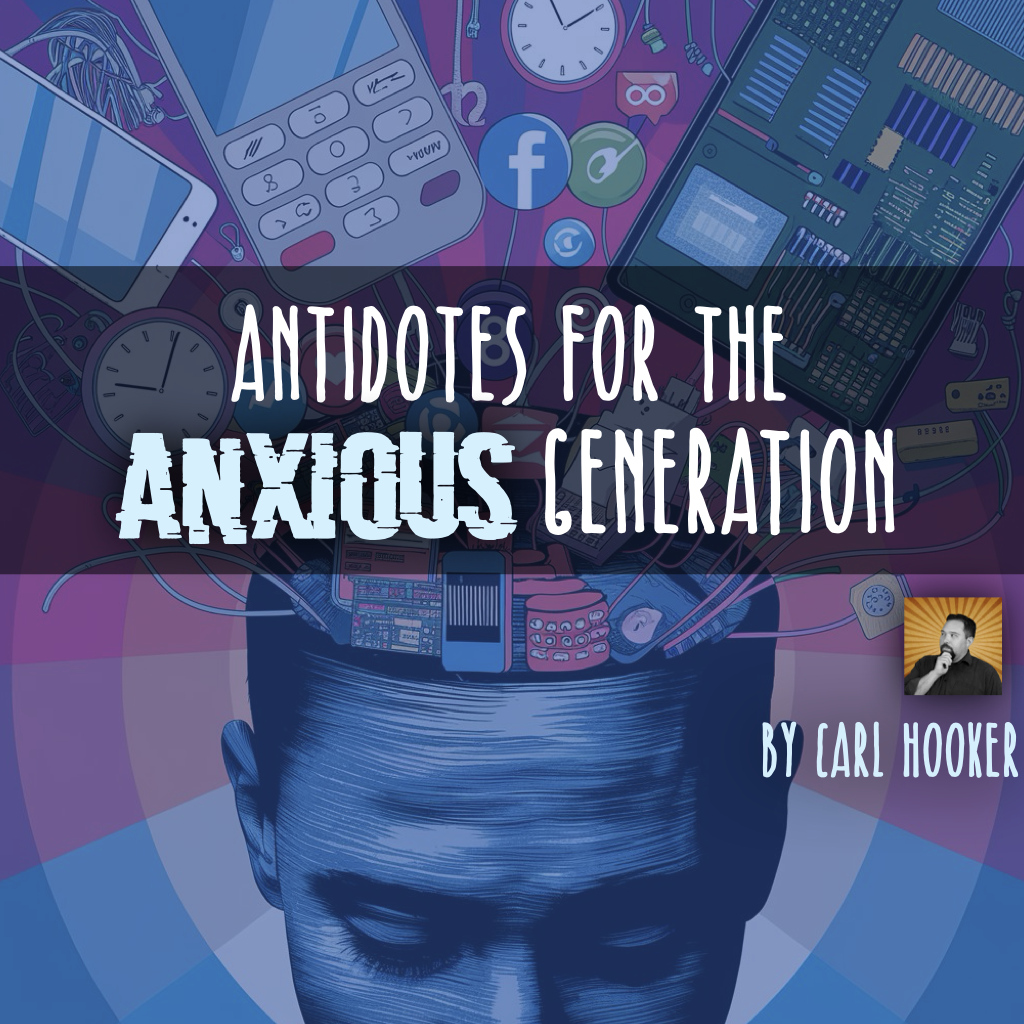Forward to Different Part 3 Repairing the Educator Pipeline

Editor’s Note: This the second in a series of blog posts reimagining how schools should move going forward. Taking to account the current state of K-12 schools, the increase in teachers and leaders leaving the field and the tools we have available to us. Check out the overview post here.
During a recent panel at CoSN22, leaders from various positions and locations in education convened to discuss the current state of K12. This forward-thinking group handled most of the issues around how to handle the political unrest, communication and social media with ease. But when I asked them how do we stop the massive exodus of people from the profession, there was some noticeable hesitation on their response.
This is a multi-faceted problem with no easy solution. A recent survey by K12Leaders.com found that the top reason why teachers are leaving the profession is LACK OF RESPECT and SUPPORT. They no longer feel like they can be autonomous and creative when it comes to teaching and learning. In short, as one panelist mentioned,
“The joy is getting sucked out of education”
– K12 Administrator
Lack of Support
Issues like teacher pay and lack of flexibility also weighed heavily on the survey, but most teachers shared stories of either administration not supporting them or “parents gone wild.” Overbearing and entitled parents displace blame from their child to the teacher or school. Teachers feel hand-cuffed and have started to throw their hands up when it comes to classroom discipline. When they do discipline a student, they fear repercussion from social media or blame and shame from the parent.
Without support from leadership, teachers feel forced to teach conservatively and let discipline issues slide. This leads to greater distractions in the classroom which means less learning taking place. The hassle of dealing with “snowplow” parents means they will do their best not to rock the boat.
When I interviewed some middle school teachers recently, they admitted to making sure tests and quizzes were easy enough for kids to get an A or B just so the parents wouldn’t be breathing down their neck. As you might imagine, this could create a domino effect where students aren’t faced with any rigorous challenges during their time in K12, thus not preparing them for the grit and resilience needed for the future.
Possible solution: Administrators are already feeling the pressure from parent groups (see next point) on a variety of issues. They must set up clear guidelines and expectations for student behavior and then be prepared to field any parent concerns or complaints. In addition, leaders need to create learning opportunities for their staff and create an environment where thoughtful risk and failure is embraced.
School leaders can also help bear some of the burden by giving teachers the gift of time and subbing for their class, even if it’s just a couple of hours. I mentioned this to a staff at a recent keynote in New York and received a loud applause. I know this is a lot to put on administrators, but as instructional leaders, it’s important to still be a teachers and learner in your school. All of this will require a level of bravery but the respect and feeling of support gained by your staff will make it worth it.
The political playbook
Recently, I learned that a dear friend and progressive superintendent resigned his position. When I asked a colleague about the reason he said, “The school board finally got their way.” Stories abound of leaders leaving due to school board outbursts and political pressure. Heck, in my old district, they even flew a banner over the stadium trying to get my former boss fired.
This disruptive and destructive talk from loud parent groups are all coming from the same playbook. Before it was the current outrage of Diversity, Equity and Inclusion (DEI) it was Critical Race Theory (CRT). And before that it was banning books with any LGBQT messaging. And before that it was mask mandates. The truth is, it’s always something with theses parents groups.
In this graphic below, you can even see how they are creating multiple Facebook groups with the sole purpose of attacking libraries and challenging books. The words they use are the same as are their methods of attack (board meetings and open records requests).
An example of Facebook groups formed to challenge books
As you can see, with the virtual pulpit of social media, the voices of discontent have become a steady roar. These small, vocal groups are running for school boards and overturning progressive policies with their not-so-hidden agenda. In Texas, with the support of the governor, a librarian was fired for not removing certain books on the shelf.
What does all this noise do? It distracts from the real issues in education (like teacher pay, student support) and is causing school leaders to burn out and find other careers. Curriculum is deadlocked and any type of teaching with freedom of thought is demonized as potential brain-washing.
Possible solution: This issue is probably the most complex as we don’t have a way of blocking parent voices on social media or during school board meeting proceedings. The truth is, the best way to handle some of the dog whistle issues is to not breathe life into them. We need to spend time telling and sharing the story of K12 education to the masses in order to drown out the noise. Parents that are seeing this disruptive and childish behavior can support schools by running for elected positions that support school progression, not halt it. Refocus the discussion on staff salary and support rather than what book we need to burn next.
A rapidly drying pipeline from higher ed
One of the most disturbing trends in education is the rapid decline of people studying to become teachers. One higher ed employee shared with me that their teacher prep programs are operating at 10% capacity. That means not only do we have the mass exodus of experienced teachers, but now we have no one fresh coming in to take their place. Teaching is seen as a dead-end position with a lot of stress for very little salary. As the pipeline begins to dry up, schools will have to double up on class size with the remaining teachers, due to lack of warm bodies to support the students.
I recently interviewed a couple of professors on the Learning Unleashed podcast about this very topic. They too were concerned with the pipeline and had some ideas around possibly marketing the position better, but ultimately, nothing that hadn’t been tried before. This is much bigger than a marketing and PR issue. Generation Z sees the vitriol out there and the negativity and feel the value of shaping young minds isn’t worth the hassle.
Possible Solution #1: K12 needs to invest some energy and money into this pipeline. When I was a student teacher it was one of the hardest years of my life. I was paying for school as well as teaching all day and taking 18 hours worth of classes. An enterprising school district could see the lack of incoming talent and incentivize more to enter the field by PAYING for their final year or two of college as they begin student-teaching. This would serve a couple of purposes:
- It would encourage students to major in teaching since it would pay for part of their college if not all of it, thus reducing their debt.
- Districts could grant those dedicated to the program entry into their schools and essentially guarantee them a job.
Potential risks here would be a student-teacher electing not to teach after they graduate, so some sort of work for loan forgiveness would have to be offered. Also, someone in the program may realize they are not cut out for teaching but be forced to complete a year as a way to get their loan forgiven.
Possible solution #2: Go the alternative education route. Encourage and incentivize adults already out of college (or high school) to go through a crash course in teaching and emergency certification. Removing certification requirements and even college degrees would open up a wider field. With proper training and support, some diamonds in the rough could be discovered that might not have originally considered teaching as a viable option as a profession.
Who will be left to lead us?
The trickle down effect of a teacher shortage is a leadership shortage. I recently spoke with Doug Roberts of the Institute for Educational Innovation (IEI) about this very topic. His organization is a think tank for superintendents and district leadership. He said that normally, a high profile superintendent position would garner over 100 applicants. They are now seeing single digit applicants and in some cases, no one interested in the role.
Leading a school or district used to carry with it prestige and respect. Now, it’s seen as a target by the information-mongers out there seeking to control school boards with their short-sighted intent. Dealing with a contentious school board is akin to managing a tyrant, only in this case it is a tyrannical minority. A small group of individuals who control the actions of the many and ultimately the hiring and firing of a superintendent and other leadership. In many cases they are the extended arm of a small group of disgruntled and vocal parents seeking to control every aspect of their child’s learning experience.
For example, in my former district, there is a group of parents trying to ban YouTube and other apps off all student devices. Putting development technology usage arguments aside, they are trying to dictate their beliefs and values on the entire district, putting administrators in a awkward position. Not only that, but they are passing the blame of their own child’s behavior on the school and IT department. What should be a shared conversation has become contentious and part of the blame game. My analogy for this is it would be akin to calling up a store and blaming the store manager for their child stealing something.
Principals and campus leaders are also starting to look else where for work. In many ways they are the first line of defense on parent attacks. They are trying to support their teachers but also getting brow-beat over “pass the buck” parents who’s expectations of schools have become completely out of whack. They are bringing unreasonable expectations and demands to personalize every aspect of their child’s education to a school that is overworked, underpaid, and understaffed.
Possible solution: Creating opportunities for current teachers to step into leadership roles has always been a challenge in schools. The options are essentially assistant principal, principal, or some sort of centralized position (in larger districts). Creating teacher leadership teams and opportunities for teacher growth are key to keeping potential and current leaders in house.
Creating a leadership cadre that gives teachers an opportunity their chance to lead and own different initiatives on campus can be empowering. Giving teachers opportunities to test the waters as a leader and creating support positions like instructional coaches can keep the leadership pipeline flowing.
Summary
The broken pipeline is a multi-faceted problem that will take industry experts, higher education, legislators, and K12 leaders to solve. Motivating potential teachers to join the profession and then keeping them here is key. This problem will take all stake-holders and unique thinking to fix the pipe. I don’t claim to have any of the answers but I did decide to reach out to my PLN on Twitter to ask how we attract and retain teachers. Here’s a few responses:
Another nod that micromanaging might not be the best thing.
Collaborative decision making and culture for the win!
Paid internships gaining some steam. And now, the most simple and direct response…
It’ll take all of these and more to help fix the pipeline in the next few years. We have to stop sticking our heads in the sand and hoping it’ll all get better. The future is different, we are never going back to normal.
Recommend0 recommendationsPublished in Leadership Voices, State of Education






Thanks Carl- important thoughts for increasing the educator pipeline!